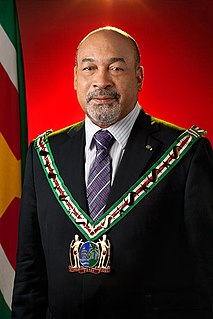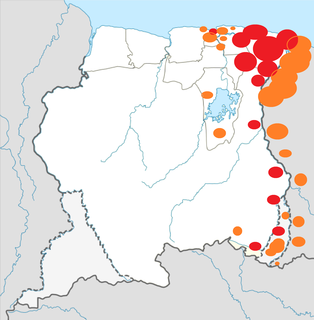After the creation of the Statute of the Kingdom of the Netherlands, the Royal Netherlands Army was entrusted with the defence of Suriname, while the defence of the Netherlands Antilles was the responsibility of the Royal Netherlands Navy. The army set up a separate Netherlands Armed Forces in Suriname. Upon independence in 1975, this force was turned into the Surinamese Armed Forces. On February 25, 1980, a group of 15 non-commissioned officers and one junior officer, under the leadership of sergeant major Dési Bouterse, staged a coup d'état and overthrew the Government. Subsequently, the SKM was rebranded as the National Army.

Desiré Delano "Dési" Bouterse is a Surinamese politician who served as President of Suriname from 2010 to 2020. From 1980 to 1987, he was Suriname's de facto leader after conducting a military coup and establishing a period of military rule. In 1987, Bouterse founded the National Democratic Party (NDP). On 25 May 2010, Bouterse's political alliance, the Megacombinatie, which included the NDP, won the parliamentary elections, and on 19 July 2010, Bouterse was elected as President of Suriname with 36 of 50 parliament votes. He was inaugurated on 12 August 2010.

The Jungle Commando was a guerrilla commando group in Suriname. It was founded by Ronnie Brunswijk in 1986 to ensure equal rights for Suriname's minority Maroon population. The group was formed after the Suriname troops committed mass murder against 35 people in Moiwana Village, near Moengo, after the Suriname national army failed to capture Ronnie Brunswijk. The commando fought against Dési Bouterse and the Surinamese army in the Suriname Guerrilla War.

Moengo is a town in Suriname, located in the Marowijne district, between Paramaribo and the border town Albina on the Cottica River. Moengo is also a resort (municipality) in the district of Marowijne. Moengo was the capital of Marowijne District between 1932 and 1945. The current capital is Albina.

Paul Slamet Somohardjo is a Surinamese politician of Javanese descent. Somohardjo has been called Paul Salam Somohardjo since childhood. Somohardjo also owns a radio and television station.

Meerzorg is a town in Suriname, located on the eastern bank of the Suriname River, directly opposite the capital Paramaribo. Its population at the 2012 census was 12,405. Since 2000 it has been connected to Paramaribo by the Jules Wijdenbosch Bridge, named after the former President Jules Wijdenbosch.

The Surinamese Interior War was a civil war waged in the remote interior region of Suriname between 1986 and 1992. The war was fought by the Tucayana Amazonas led by Thomas Sabajo and the Jungle Commando led by Ronnie Brunswijk, whose members originated from the Maroon ethnic group, against the National Army led by then-army chief and de facto head of state Dési Bouterse.

Johan Adolf "Jopie" Pengel was a Surinamese politician, and prime minister of Suriname from 30 June 1963 to 5 March 1969 for the National Party of Suriname (NPS).

Netherlands–Suriname relations refers to the current and historical relations between the Netherlands and Suriname. Both nations share historic ties and a common language (Dutch) and are members of the Dutch Language Union.

Pikin Santi, sometimes spelt as Pikien Santi, is a Ndyuka village on the Cottica River in Suriname inhabited by the Pinasi and Piika lo. Pikin Santi is situated upstream from Pinatjaimi and Lantiwei, and downstream from Tamarin. It lies in the vicinity of the Buku creek and should therefore be close to the ruins Fort Buku, which as of yet have not been identified.

Granman is the title of the paramount chief of a Maroon nation in Suriname and French Guiana. The Ndyuka, Saramaka, Matawai, Aluku, Paramaka and Kwinti nations all have a granman. The paramount chiefs of Amerindian peoples in Suriname are nowadays also often called granman.
Roy Dennis Horb was a Surinamese military officer. He was one of the sergeants who committed a military coup in Suriname on 25 February 1980, and the right hand man of army leader Dési Bouterse.
Bokilifu Boni was a freedom fighter and guerrilla leader in Suriname, when it was under Dutch colonial rule. Born in Cottica to an enslaved African mother who escaped from her Dutch master, he grew up with her among the Maroons in the forest. He was such a powerful leader that his followers were known as Boni's people after him. They built a fort in the lowlands and conducted raids against Dutch plantations along the coast. Under pressure from Dutch regular army and hundreds of freedmen, they went east across the river into French Guiana. Boni continued to conduct raids from there, but was ultimately killed in warfare.

Surendre Sradhanand "Soerinder" Rambocus was a Surinamese serviceman. For a short period, he was the highest ranking officer of the Suriname National Army. He was involved in the unsuccessful coup d'état of March 1982 against the then dictator of Suriname, Dési Bouterse, and was executed on 8 December 1982 as one of the December murders.

Edmund Alexander "Eddy" Hoost was a Surinamese politician and lawyer. He was Minister of Justice and Police between 1973 and 1977. After the independence of Suriname, he became the first Minister of Defence and served until 1977. He was one of the victims of the December murders.
Adriaan Cornelis Jasper Marius Alberga was a Surinamese jurist. He served as Minister of Justice and Police from 1951 to 1952, and was Prime Minister of Suriname in 1952.
Jacques Adam Drielsma (14 October 1886 – 31 July 1974) was a Surinamese lawyer and notary who served as acting Prime Minister of Suriname in 1951, and Finance minister between 1949 and 1952. In 1957, he was sentenced to two years for embezzlement.

Olton Willem van Genderen was a Surinamese civil servant and politician. He served as Deputy Prime Minister of Suriname from 24 December 1973 until the coup d'état of 25 February 1980. He was one of the main negotiators for the Independence of Suriname.

Berlijn is a village and former wood plantation in the resort of Zuid in the Para District in Suriname. It is located on the Para Creek, and about 4 kilometres (2.5 mi) from the Johan Adolf Pengel International Airport.

Onverdacht is a village in the resort of Zuid in the Para District of Suriname. Between 1941 and 2009, it was a bauxite mining town.
















